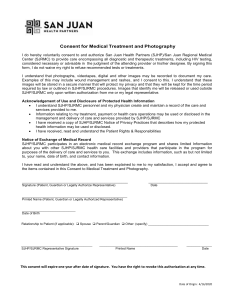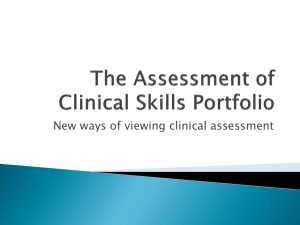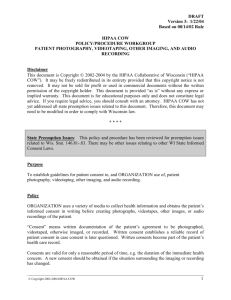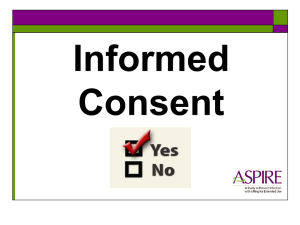photography/videotaping/other imaging/audio recording for
advertisement
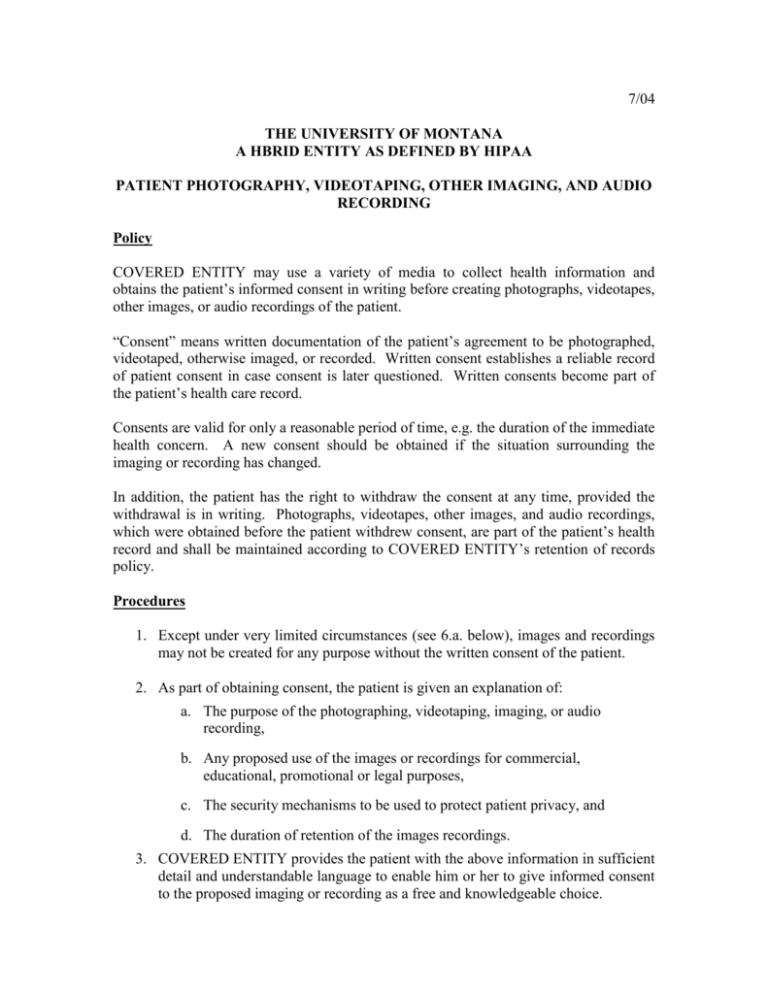
7/04 THE UNIVERSITY OF MONTANA A HBRID ENTITY AS DEFINED BY HIPAA PATIENT PHOTOGRAPHY, VIDEOTAPING, OTHER IMAGING, AND AUDIO RECORDING Policy COVERED ENTITY may use a variety of media to collect health information and obtains the patient’s informed consent in writing before creating photographs, videotapes, other images, or audio recordings of the patient. “Consent” means written documentation of the patient’s agreement to be photographed, videotaped, otherwise imaged, or recorded. Written consent establishes a reliable record of patient consent in case consent is later questioned. Written consents become part of the patient’s health care record. Consents are valid for only a reasonable period of time, e.g. the duration of the immediate health concern. A new consent should be obtained if the situation surrounding the imaging or recording has changed. In addition, the patient has the right to withdraw the consent at any time, provided the withdrawal is in writing. Photographs, videotapes, other images, and audio recordings, which were obtained before the patient withdrew consent, are part of the patient’s health record and shall be maintained according to COVERED ENTITY’s retention of records policy. Procedures 1. Except under very limited circumstances (see 6.a. below), images and recordings may not be created for any purpose without the written consent of the patient. 2. As part of obtaining consent, the patient is given an explanation of: a. The purpose of the photographing, videotaping, imaging, or audio recording, b. Any proposed use of the images or recordings for commercial, educational, promotional or legal purposes, c. The security mechanisms to be used to protect patient privacy, and d. The duration of retention of the images recordings. 3. COVERED ENTITY provides the patient with the above information in sufficient detail and understandable language to enable him or her to give informed consent to the proposed imaging or recording as a free and knowledgeable choice. 4. A health care provider (physician, registered nurse, physician assistant, psychologist, counselor, etc.) is responsible for providing the patient with an appropriate explanation of the imaging or recording and obtaining his or her informed consent in writing. 5. Circumstances that may involve patient imaging or recording include: a. Documentation of abuse and neglect: Reportable cases of actual or suspected abuse and neglect do not require consent from the patient prior to photography, videotaping, and other imaging. These images may be submitted to the investigating agency with appropriate authorization/court order, but are not to be used for other purposes without consent. b. Research: Consent for imaging or recording must be explicitly stated in the patient’s consent for participation in the research protocol. COVERED ENTITY’s institutional review board or privacy board must approve the creation of images and recordings as part of a research protocol. c. Telemedicine (including e-mail) and Internet transmission: Consent for COVERED ENTITY to use images or recordings for these purposes must be explicitly stated in the patient’s written consent. The images or recordings, along with the medical record, should be encrypted in order to protect the patient’s privacy. d. Medical education or teaching: Consent for COVERED ENTITY to use images or recordings for these purposes must be explicitly stated in the patient’s written consent. e. Marketing/Fundraising/Publicity/Media: Authorization/consent for COVERED ENTITY to use images or recordings for these purposes must be explicitly stated in the patient’s written authorization/consent. f. Law enforcement or legal purposes: Consent for COVERED ENTITY to use images or recordings for these purposes must be explicitly stated in the patient’s written consent. g. Videotaping for Trauma Certification/Performance Improvement Purposes: Videotaping as a documentation “tool” for peer review, performance improvement activities, or trauma certification may be carried out with patient authorization. However, viewing is limited to authorized staff as per COVERED ENTITY guidelines. The videotapes are not considered a part of the patient’s health information and will be erased following completion of the performance improvement process. h. Photography of Newborns: Consent of the parent must be obtained prior to the taking of photographs of newborns as a courtesy or for sale. i. Family/Friends: Documented consent is not needed for imaging or audio recording done by the patient’s family members or friends. However, if a family member or friend has the consent of the patient to videotape a birth or procedure, for example, this should be done only with the agreement of the attending physician and acknowledgement that the individual may be required to discontinue taping if the attending physician deems it necessary. 7. COVERED ENTITY may not release images and recordings to individuals or Covered Entity’s outside COVERED ENTITY without specific authorization from the patient, except when required by law or when the images or recordings have been “de-identified” and are no longer considered individually identifiable health information. 8. COVERED ENTITY may determine that images and recordings are not individually identifiable health information only if identifiers, including full-face photographic images and any comparable in ages of the individual or of relatives, employers, or household members of the individual, are removed. (See COVERED ENTITY Destruction and Disposal of PHI Policy.) 9. Storage and retention of images and recordings: a. Images and recordings must be clearly identified with the patient’s name, identification number and/or date of birth, and date of image or recording. Media must be stored securely to protect the patient’s confidentiality. If used to document patient care, images and recordings will be stored in compliance with the COVERED ENTITY’s retention of records policy and state law. b. Still images and recordings created for medical purposes may be filed with the patient’s health care record. c. Sensitive images and recordings may be stored in sealed envelopes within the patient’s health care record. [Certain portions of this policy were reproduced, with permission, from a document copyrighted by HIPAA COW 2002] PATIENT CONSENT/AUTHORIZATION PHOTOGRAPHY/VIDEOTAPING/OTHER IMAGING/AUDIO RECORDING FOR TREATMENT, EDUCATION, MARKETING OR MEDIA PURPOSES Patient’sName:________________________________________MR#_______________ Address:________________________________________________________________ ________________________________________________________________________ PhoneNumber:___________________________________________________________ I hereby give my consent to have photographs, videotaped images, other images, or audio recordings made of my family member or myself for the following purposes: Covered Entity Marketing or Publicity Purposes Event: ____________________________________________________________ Interviews with News Media Covered Entity/s: ___________________________________________________________ Educational Purposes Other: __________________________________________________________________ Signature of Patient or Legal Representative/Relationship Witness Date Date


